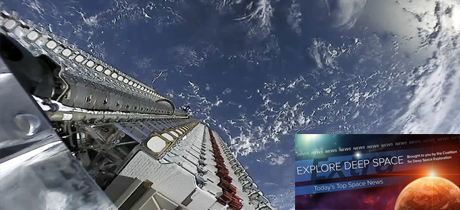In Today’s Deep Space Extra… Scientists caution proposed cuts in NASA science missions could slow Mars exploration. Wednesday marked the 50th anniversary of Earth Day, demonstrating the home planet remains a focus of those exploring space, whether they be astronauts or satellites.
Space Science
Scientists warn proposed cuts put Mars science program at risk
SpaceNews.com (4/22): Scientist involved in NASA Mars missions caution that proposed budget cuts could stall efforts to explore the Red Planet, a destination for future human exploration. The warnings emerged during a Mars Exploration Program Analysis Group meeting earlier this month. NASA’s 2021 budget proposal would terminate the Mars Odyssey mission in orbit since 2001 and reduce funding for the Curiosity rover, which has been exploring the Martian surface since 2012, by 20 percent. Odyssey images the Martian surface and serves as a communications relay for other missions on the Martian surface. Curiosity is seeking evidence of past habitable Martian environments.
The first, chilling images of Earth
Mashable (4/22): A tradition of looking back at the Earth and taking an image, whether by a scientific spacecraft or an astronaut aboard a spacecraft, winds back decades to the first rockets test launched from the U.S. Southwest. Some of the most stirring images came from NASA’s distant Voyager 2 and Apollo astronauts at the Moon. “There seems to be an irresistible tendency to look back at home,” said Bill Barry, NASA’s chief historian. Wednesday marked the 50th anniversary of Earth Day.
Astronomers may have captured the first ever image of nearby exoplanet Proxima C
Scientific American (4/21): Proxima C, first noticed in 2019 is a possible planet orbiting the closest star to the sun, Proxima Centauri. In a study awaiting publication in the journal Astronomy and Astrophysics, scientists believe they may have directly imaged the planet, which qualifies as a super Earth or mini Neptune.
Osiris-Rex clears one test, prepares for June trial
Aviation Week Intelligence Network (4/22): NASA’s Osiris-Rex asteroid sample return mission on April 14 successfully rehearsed the early maneuvers planned for an August 26 attempt to briefly contact the surface of the primitive asteroid Bennu to gather up to 4.4 pounds of soil and rock. Osiris-Rex is to depart Bennu in March 2021, returning to Earth to drop off a sample container on September 24, 2023.
Chase a potentially hazardous asteroid as it flies by Earth
Sky and Telescope (4/22): The asteroid 1998 OR2, discovered in 1998 and about 1.3 miles wide, will pass within four millions miles of the Earth early next Wednesday. The object is bright enough to be seen with a small telescope.
Op Eds
Space startups, Darwin and the coronavirus
SpaceNews.com (4/21): In an op-ed, X-Prize founding board member Rick Tumlinson urges policy makers and others in an influential position not to overlook space startups in their efforts to weather the coronavirus pandemic. Prizes, grants, investment incentives, debt relief and other creative solutions are much needed to help the small companies achieve financial success, he writes.
Other News
SpaceX is getting closer to offering internet coverage after Wednesday’s Space Coast launch
Orlando Sentinel (4/22): A SpaceX Falcon 9 rocket launched from NASA’s Kennedy Space Center (KSC) on Wednesday at 3:30 p.m., EDT, placed 60 of the company’s Starlink internet connectivity small satellites in orbit. The launch brings the orbiting Starlink total to more than 400 and SpaceX closer to its goal of offering a satellite internet service.

